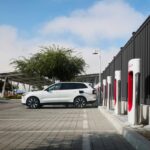The Toyota Urban Cruiser has officially debuted as the automaker’s latest foray into the realm of electric vehicles (EVs), though it may look familiar to some.
This fresh iteration serves as a subtly redesigned version of the recently unveiled Suzuki e Vitara, sporting an updated ‘hammerhead’ front-end aesthetic that seeks to harmonize with contemporary Toyota models, including the Prius and the bZ3X, which is aimed at the Chinese market.
Beyond the visual tweaks, such as distinctive taillight designs and unique badging, modifications remain minimal.
While the Urban Cruiser is confirmed for the European market, its availability in Australia remains unverified. A spokesperson for Toyota Australia noted, “The new Urban Cruiser represents an exciting advancement in Toyota’s electrification strategy. While we continuously seek to broaden our product lineup for customers, we have no announcements to make today.”
Currently, numerous new car promotions are accessible through CarExpert. Take advantage of expert insights and secure an exceptional deal today.
Toyota has outlined ambitious plans for its European offerings, intending to feature 15 zero-emission vehicles by 2026, which will include six models built on a dedicated EV platform. In contrast, the company has adopted a more tempered approach in Australia, announcing earlier this year a goal of introducing three EVs into the market by 2026.
The Urban Cruiser’s close relationship to the e Vitara extends to its mechanical specifications, remaining unchanged in this regard.
Front-wheel-drive variants offer customers options between 49kWh and 61kWh lithium-iron phosphate (LFP) battery packs, whereas all-wheel-drive configurations arrive exclusively equipped with the larger 61kWh LFP battery.
With the smaller battery configuration, the front-wheel-drive models generate 106kW of power alongside 189Nm of torque. Opting for the larger battery increases output to 128kW, while selecting all-wheel drive enhances power to 135kW and torque to 300Nm.
A standard heat pump feature is included across all battery options, accompanied by manually operated battery pre-warming capabilities.
In terms of dimensions, the Urban Cruiser mirrors the e Vitara closely, with the exception of a slight 10mm extension in overall length:
Toyota Urban Cruiser
Length: 4285mm
Width: 1800mm
Height: 1640mm
Wheelbase: 2700mm
This SUV boasts a wheelbase that is 140mm longer than that of the Yaris Cross, despite being 105mm longer overall, and utilizes a new dedicated EV framework.
Known as Heartect-e, this platform represents a collaborative development between Suzuki and Daihatsu, showcasing a robust alliance among the automotive brands.
The Urban Cruiser is available with either 18- or 19-inch alloy wheels, and offers an optional fixed sunroof for those seeking additional features.
Inside, the vehicle impresses with a 10.25-inch digital instrument cluster and a 10.1-inch touchscreen infotainment system, compatible with both Android Auto and Apple CarPlay.
The rear seating area features a versatile 40:20:40 split/fold arrangement that includes sliding functionality, complemented by a 12-color ambient lighting option. Additional perks may include an electrically adjustable driver’s seat and a premium JBL audio system.
Safety is prioritized with standard features such as adaptive cruise control, lane-keeping assistance, and a surround-view camera system. All-wheel-drive variants additionally offer hill-descent control to enhance driver confidence.
This is not the first time the Urban Cruiser nameplate has graced the market.
Historically, it has been utilized for a European variant of the Toyota Ist/Scion xD, an Indian-market Suzuki Vitara Brezza, and a version of the current Suzuki Grand Vitara tailored for African and Middle Eastern markets.
Toyota and Suzuki have a long-standing tradition of collaboration, frequently sharing platform developments and rebranding vehicles in various markets. For instance, Toyota rebadges the Suzuki Baleno as the Starlet in South Africa, while Suzuki offers the Toyota Corolla and RAV4 under the names Swace and Across, respectively, in Europe.
Toyota maintains a stake of approximately five percent in Suzuki, reinforcing their strategic partnership in the automotive landscape.
For further insights, see: 2025 Suzuki e Vitara, an electric SUV poised to carry Toyota branding.
Source:www.carexpert.com.au






